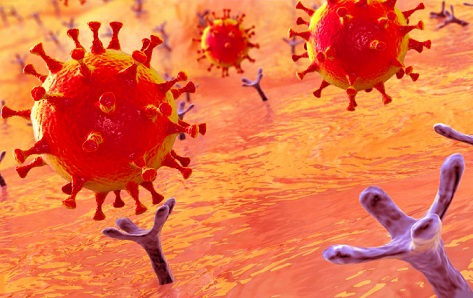Glutamyl Aminopeptidase (APA), Encoded by the Gene ENPEP Could Be Another Human Receptor for SARS-CoV-2
Nikhil Prasad Fact checked by:Thailand Medical News Team Dec 15, 2024 3 months, 4 weeks, 1 day, 7 hours, 54 minutes ago
Medical-News-The fight against COVID-19 has propelled research into uncharted territories. Scientists from Tampere University and the University of Oulu in Finland have unveiled findings suggesting that glutamyl aminopeptidase (APA), encoded by the ENPEP gene, might serve as another receptor for SARS-CoV-2. Known primarily for its role in the renin-angiotensin-aldosterone system (RAAS), APA could potentially join the ranks of ACE2, TMPRSS2, and NRP1, proteins that facilitate viral entry into human cells.
 Glutamyl Aminopeptidase (APA), Encoded by the Gene ENPEP Could Be Another Human Receptor for SARS-CoV-2
Glutamyl Aminopeptidase (APA), Encoded by the Gene ENPEP Could Be Another Human Receptor for SARS-CoV-2
This
Medical News report dives deep into the study’s findings and its implications for understanding COVID-19 pathophysiology. Importantly, the researchers highlight APA's correlation with ACE2, particularly in tissues like the small intestine and kidney cortex, which are not traditionally associated with respiratory illnesses but are increasingly recognized in SARS-CoV-2 studies.
Investigating ENPEP's Role
Using advanced bioinformatics, researchers analyzed RNA sequencing data from over 17,000 samples spanning 49 human tissues and single-cell data from 2.5 million cells. These analyses revealed high ENPEP expression in the small intestine’s enterocyte brush border and kidney cortex, where ACE2 expression is also pronounced.
The study further mapped ENPEP’s expression across various tissues, uncovering its presence in systemic vasculature, the heart, and even specific cell types in the brain, such as ependymal cells—an unexpected finding. However, its expression in the lower respiratory tract, a critical site for SARS-CoV-2 infection, was found to be low, raising questions about its role in the virus's respiratory tropism.
Key Study Findings
Expression Patterns
The researchers found that ENPEP expression varies across tissues:
-High Expression: Small intestine, kidney cortex.
-Moderate Expression: Liver, vascular tissues, and specific brain cell types like ependymal cells.
-Low Expression: Lower respiratory tract tissues like alveolar fibroblasts.
Interestingly, APA's immunohistochemical staining corroborated these findings, showing strong signals in the small intestine's apical membrane and kidney glomeruli, but minimal activity in lung alveoli.
Age and Sex Variations
Age-related analysis revealed that ENPEP expression increases in the prostate and skeletal muscle but decreases in the heart and aorta. No significant differences were found in the lung, intestine, or kidney. This nuanced understanding could explain why COVID-19 severity varies with age.
Correlation with ACE2 a
nd Angiogenesis
One of the most striking discoveries was ENPEP’s strong correlation with ACE2 in tissues like the small intestine and kidney cortex, suggesting a shared role in SARS-CoV-2 pathophysiology. The gene also showed significant coexpression with factors linked to angiogenesis, including neuropilin-1 (NRP1), a known facilitator of viral entry.
Potential Implications for COVID-19
The study opens up new possibilities for understanding SARS-CoV-2. APA's involvement in the RAAS suggests it could contribute to the vascular and systemic effects seen in severe COVID-19 cases. With ACE2 often impaired during infection, APA might partially compensate for its enzymatic functions, altering angiotensin metabolism and influencing outcomes like blood pressure dysregulation and coagulopathy.
However, as APA expression is low in the respiratory tract, its role might be more significant in extrapulmonary manifestations of COVID-19, such as gastrointestinal symptoms or kidney damage.
Conclusions
The findings position ENPEP as a compelling candidate for further research into SARS-CoV-2’s host receptor repertoire. Its overlap with ACE2 in critical tissues and its role in RAAS could help unravel new mechanisms of viral pathogenesis. Moreover, understanding ENPEP's tissue-specific roles might guide targeted therapies for COVID-19's diverse manifestations.
However, more experimental studies are needed to confirm APA's direct interactions with SARS-CoV-2. The potential for ENPEP to act as a secondary or auxiliary receptor highlights the complexity of host-virus interactions and underscores the need for multifaceted research approaches.
The study findings were published in the peer-reviewed journal: PLOS ONE.
https://journals.plos.org/plosone/article?id=10.1371/journal.pone.0307731
For the latest COVID-19 News, keep on logging to Thailand
Medical News.
Read Also:
https://www.thailandmedical.news/news/breaking-sars-cov-2-also-binds-to-histamine-receptor-h1-for-cell-entry
https://www.thailandmedical.news/news/tlr2-and-tlr4-are-novel-activating-receptors-for-sars-cov-2-spike-protein-in-nk-cells
https://www.thailandmedical.news/news/covid-19-induced-kidney-damage-caused-by-sars-cov-2-using-receptors-such-as-tlr-4-kim-1-tim-1-and-cd147
https://www.thailandmedical.news/news/sars-cov-2-uses-asialoglycoprotein-receptor-1-to-infect-hepatocytes
https://www.thailandmedical.news/news/covid-19-news-ukrainian-scientist-warns-that-the-alpha-7-nicotinic-acetylcholine-receptors-are-responsible-for-many-long-covid-manifestations
https://www.thailandmedical.news/news/breaking-news-covid-19-research-scientist-discover-that-sars-cov-2-can-gain-entry-into-cells-using-cat,-agtr2,-l-sign-and-dc-sign-receptors
https://www.thailandmedical.news/news/breaking-news-covid-19-research-shows-that-sars-cov-2-spike-proteins-also-targets-nicotine-acetycholine-receptors-in-human-host,-massive-alarming-impl
https://www.thailandmedical.news/news/covid-19-news-chinese-researchers-warn-that-sars-cov-2-could-be-infecting-cattle-and-other-animals-via-axl-and-nrp1-receptors
https://www.thailandmedical.news/news/breaking-covid-19-news-study-identifies-rage-as-a-receptor-for-sars-cov-2-n-protein-and-it-also-mediates-n-protein-induced-acute-lung-injury
https://www.thailandmedical.news/news/thailand-medical-news-exclusive-novel-human-host-receptors-identified-for-sars-cov-2-cell-entry-and-attachment
https://www.thailandmedical.news/news/study-uncovers-role-of-gas6-protein-and-tam-tyrosine-kinase-receptors-in-covid-19-axl-has-been-identified-as-a-possible-sars-cov-2-receptor
https://www.thailandmedical.news/news/breaking-news-study-discovers-that-rage-is-a-receptor-for-sars-cov-2-n-protein-and-mediates-n-protein-induced-acute-lung-injury
https://www.thailandmedical.news/news/breaking-sars-cov-2-targets-endothelin-receptors,-causing-bone-and-cartilage-damage-and-joint-pains-endothelin-receptor-blocker-macitentan-helps
https://www.thailandmedical.news/news/breaking-discoveries-cell-surface-protein-hspa5-bip-grp78-unveiled-as-key-player-in-cancers-and-is-also-a-receptor-for-sars-cov-2
https://www.thailandmedical.news/news/breaking-brazil-study-provides-evidence-that-sars-cov-2-infects-the-astrocytes-of-the-human-brain-using-nrp1-receptors-and-causes-damage
https://www.thailandmedical.news/news/study-reveals-sars-cov-2-also-binds-with-stra6-receptors,-providing-explanation-for-symptoms-and-long-covid-conditions-with-unknown-aetiology
https://www.thailandmedical.news/news/breaking-irish-study-shows-that-integrins-could-be-receptors-for-sars-cov-2-and-integrin-signaling-upon-infection-leads-to-vascular-dysregulation
https://www.thailandmedical.news/news/breaking-european-and-canadian-study-discovers-a-new-sars-cov-2-human-host-receptor-called-lrp1-which-also-explains-certain-aspects-of-disease-progres
https://www.thailandmedical.news/news/study-reveals-sars-cov-2-binding-to-host-dpp4-receptors-causes-dysregulation-of-proteins-associated-with-diabetes,-leading-to-severe-covid
https://www.thailandmedical.news/news/breaking-omicron-will-wreak-havoc-on-your-body-weeks-later-as-it-can-bind-to-cells-using-cellular-polyanionic-receptors-like-heparan-sulfate
https://www.thailandmedical.news/news/osaka-university-study-shows-that-older,-obese-diabetics-are-at-risk-of-severe-covid-19-due-to-grp78-receptors-which-are-highly-expressed-in-fat-tissu
(Many more articles about SARS-CoV-2 receptors can be found on TMN site)
